Mechanism of Duhuo Jisheng Decoction based on bioinformatics and network pharmacology in treating osteoporosis of kidney Yin deficiency
Jian-Wei Xiao, Xu Cai, Xin-Min Huang, Fen-Lian Guo, Xin-Peng Chen, Yi-Wei Hong, Zhi-Zhong Ye
Shenzhen Futian Hospital for Rheumatic Diseases, Shenzhen, Guangdong 518000, China
Keywords:Osteoporosis Bioinformatics analysis Network pharmacology Duhuo Jisheng Decoction R software
ABSTRACT Objective: To study the active ingredients, target and mechanism of Duhuo JiSheng Decoction for the treatment of osteoporosis by bioinformatics analysis and network pharmacology. Methods: The gene expression profile of GSE56116 was acquired through the NCBI GEO database, and the software R was used for differential analysis. The Chinese medicine system pharmacology technology platform (TCMSP) was used to retrieve the chemical components, target genes of Duhuo, Fangfeng, Xixin, and Sangjisheng.The differential genes acquired from GSE56116 were intersected and analyzed by GO enrichment analysis and KEGG pathway to study the mechanism of Duhuo JiSheng Decoction. Results: A total of 33 active ingredients and 9 differential genes of Duhuo JiSheng Decoction for the treatment of Shengyin deficiency osteoporosis were screened. GO function enrichment analysis focuses on the regulation of intracellular signal transduction, calcium-mediated signaling, and steroid hormone mediated signaling. KEGG analysis showed that it was mainly concentrated in signal pathways such as P53 signal pathway, TNF signal pathway, and IL-17 signal pathway. Conclusion: Through bioinformatics and network pharmacological analysis, Duhuo JiShenng Decoction may exert therapeutic effects by acting on AR, IGFBP3, and FOS target genes.
1. Introduction
Osteoporosis is a skeletal disease characterized by low bone mass and microarchitectural deterioration, leading to impaired bone strength and increased susceptibility to fracture[1-2]. It is the most common skeletal disorder[3]. with a prevalence that is particularly high in women (female-to-male ratio between 4 and 7.5) and in Caucasians[4-5]. According to epidemiological statistics, the overall prevalence of osteoporosis in the elderly aged over 60 in China has reached 36%[6], Of which 23% are men and 49% are women. Despite the widespread availability of bone density testing worldwide, it is estimated that most patients with osteoporosis, defined by T-score ≤ -2.5, are not treated. Further, when fewer than 20% of patients with an osteoporotic fracture receive treatment for osteoporosis within the following year[4].
In traditional Chinese medicine, osteoporosis should belong to the category of "bone atrophy" and "bone paralysis".The five internal organs are related to the occurrence of osteoporosis,and the Liver, spleen and kidney are the closest. Shi Xiaolin simplified the TCM syndrome differentiation of osteoporosis for clinical application and divided it into liver and kidney yin deficiency syndrome, spleen and kidney yang deficiency syndrome, kidney deficiency and blood stasis syndrome.Among them, liver and kidney yin deficiency syndromes are more common.
Duhuo JiSheng Decoction comes from “Thousand-Golden-Prescriptions”, which consists of 13TCM,includingDuhuo,Sangji sheng,Fuling,Danggui,Baishao,Qinjiao,Dihuang,Duzhong,Fangfe ng,Niuxi,Xixin,Chuanxiong and Gancao. It has been widely used clinically in RA, osteoarthritis, osteoporosis and other diseases [9], and has achieved satisfactory results.
Based on the data in the GEO database and the TCMSP website (http://tcmspw.com/tcmsp.php) [10], this study predicts the target genes of traditional Chinese medicine to provide a new mechanism for exploring the Duhuo parasitic decoction in the treatment of OP with kidney-yin deficiency.
2. Materials and methods
2.1 Data retrieval
Using "Osteoporosis" and "Kidney Yin Deficiency" as keywords, searched in the GEO database (www.ncbi.nlm.nih.gov/geo), retrieved the GSE56116 data set, 10 patients with osteoporosis were divided into kidney yin deficiency group (n = 4), kidney yang deficiency group (n = 3), non-kidney deficiency group (n = 3) according to TCM syndrome type, and 3 healthy patients were selected as controls Group, its detection platform is GPL4133.
2.2 Differential gene analysis of chip data
Take the data of kidney yin deficiency group and healthy control group for difference analysis, analyze the downloaded data in Perl language, map the probe to the gene, remove the unloaded probe, and select multiple probes for the same gene.The number of digits is used as the expression level of the gene. The R software limma package was used for differential analysis of the mRNA encoding protein, and the absolute value of LogFC was greater than 0.5 and adjust P <0.05.
2.3 Predicting the target of Duhuo JiSheng Decoction
Through the Chinese Medicine System Pharmacology Technology Platform (TCMSP), its chemical composition is retrieved with 4 flavors of traditional Chinese medicine, such as Duhuo, Fengfeng, Xixin, and Sangjisheng.Taking oral bioavailability (OB) ≥ 30% and drug likeness (DL) ≥ 0.18 as the screening conditions for active compounds, the compounds with higher activity in TCMSP were screened and extracted, take the target genes of 4 flavors of Chinese medicine, and use Cytoscape 3.4.1 software to draw the drugcompound-target gene network.
2.4 Intersect the target genes obtained in steps 1.2 and 1.3 to obtain the potential target of Duhuo Jiji Decoction for treating kidney-yin deficiency type OP.
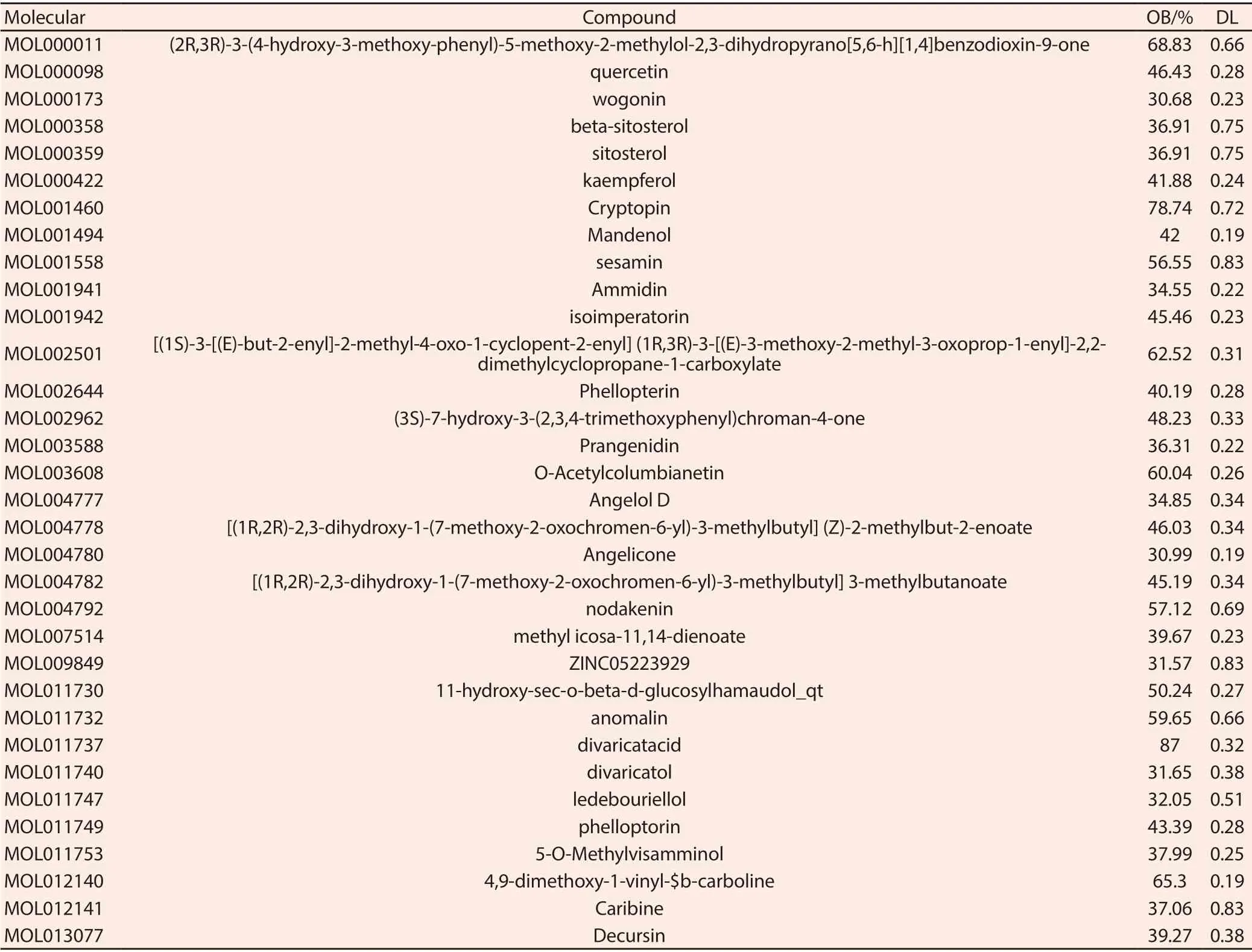
Table 1 Effective compounds after screening for Duhuo, Fengfeng, Xixin and Sangjisheng
2.5 Gene Ontology, pathway and analysis of protein interaction network analysis
Using org.Hs.eg.db and clusterProfiler packages of R software, with P <0.05 as the screening condition, GO enrichment analysis and KEGG pathway analysis of differential genes were performed. The string db database was used for protein interaction network analysis.
3. Results
3.1 The results of the difference analysis
The results of the difference analysis showed that compared with healthy patients, there were differential expressions of 893 mRNAs in the synovial tissue of patients with kidney-yin deficiency type OP, of which 490 were up-regulated and 403 were down-regulated.( Figure 1)

Figure 1 Differential genes in healthy group and kidney-yin deficiency group
3.2 TCMSP website prediction
TCMSP website prediction shows that with OB≥30% DL≥0.18 as the screening condition, after screening, there were 9 active ingredients of Duhuo, 18 of Fangfeng, 8 of Xixin, 2 of Sangjisheng, and 33 candidate compounds (containing 5 common components). The results are shown in Table 1.
3.3. Analysis of the network topology
Connect the compound to the target through Cytoscape 3.4.1 software, and draw the "drug-compound-target gene" interaction network diagram of the above four traditional Chinese medicines (Figure 2),intuitively reflect the interaction of drugs, compounds and targets. Analysis of the network topology shows that the network contains 138 nodes and 292 edges.

Figure 2 "Drug-compound-target gene" interaction network, red for the drug, blue for the effective chemical composition, and yellow for the target gene.
3.4 Analysis of the network topology
Cross the results of 2.1 (Figure 3),the predicted potential targets of 32 effective chemical components of Duhuo, Fengfeng, Xixin, and Sangjisheng are 97 and 9 common target genes are obtained (Table 2).
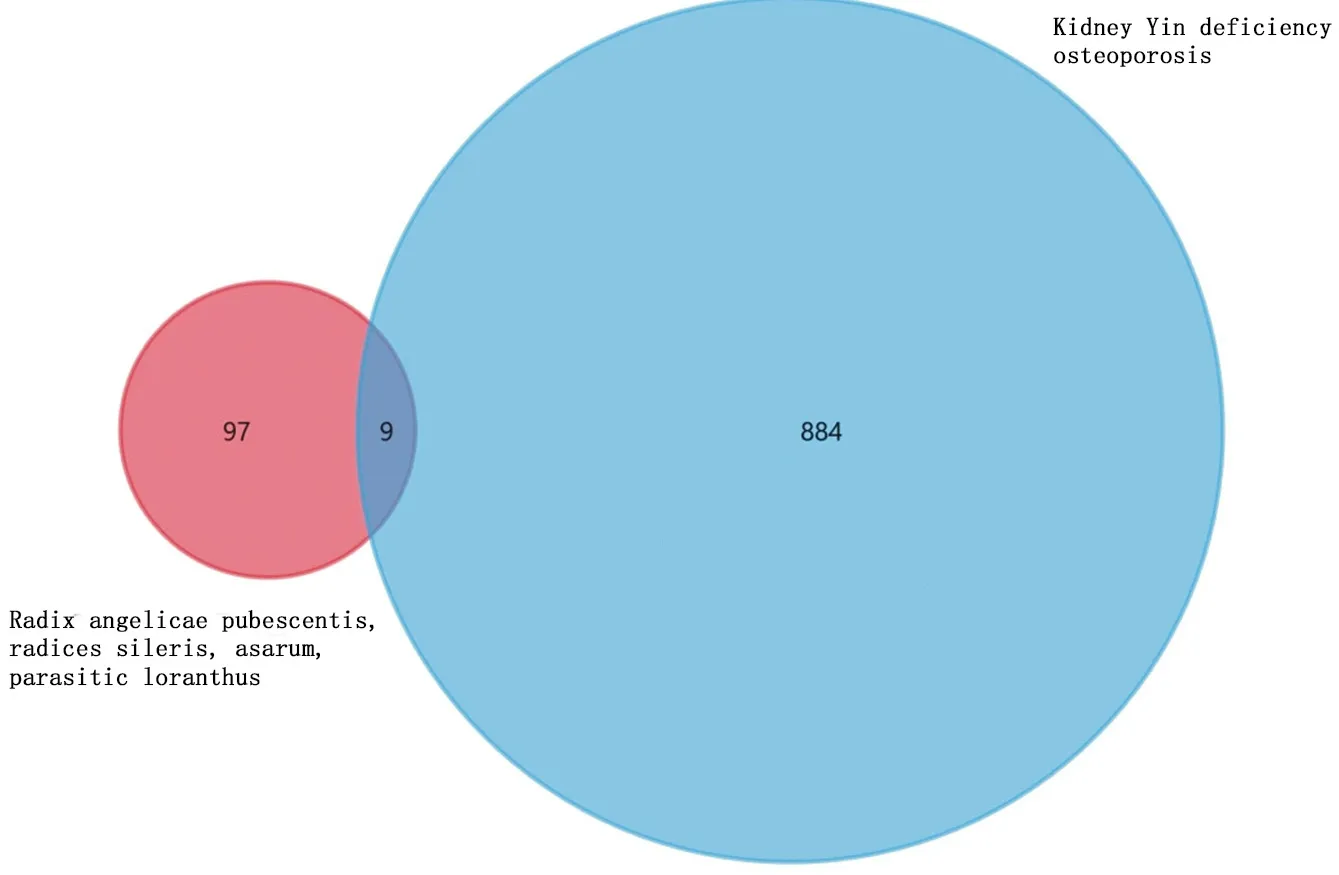
Figure 3 Venn diagram of target genes of Chinese medicine and osteoporosis of Shengyin deficiency type
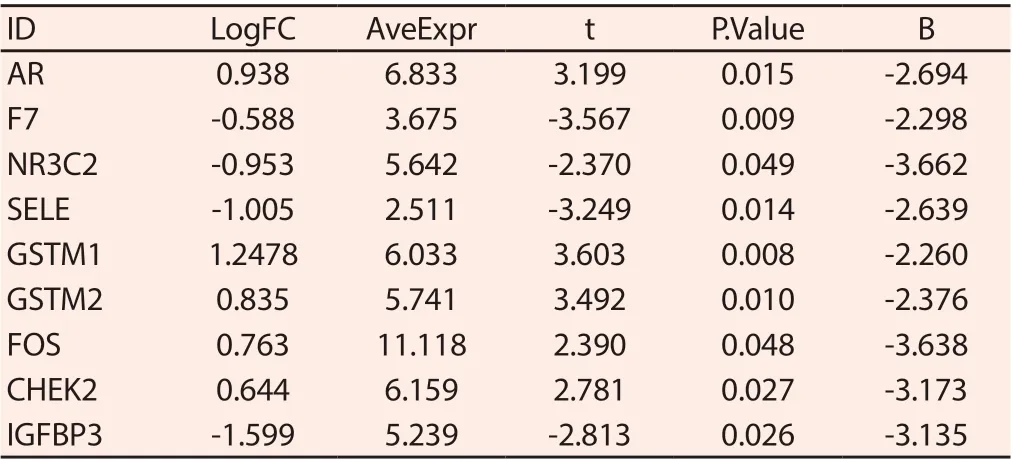
Table 2 Differentially expressed mRNA
3.5 The GO enrichment analysis
The GO enrichment analysis of differential genes showed that BP was mainly enriched in response to response to organic cyclic compound, regulation of intracellular signal transduction, calciummediated signaling, steroid hormone mediated signaling pathway, etc.MF Enriched in glutathione transferase activity, steroid hormone receptor activity, RNA polymerase II transcription factor binding, protein homodimerization activity, etc. CC display is mainly located in the endoplasmic reticulum, endomembrane system, etc. (Figure 4). KEGG analysis showed that it was mainly enriched in fluid shear stress and atherosclerosis, P53 signaling pathway, TNF signaling pathway, IL-17 signaling pathway, autophagy and other signaling pathways (Figure 5).
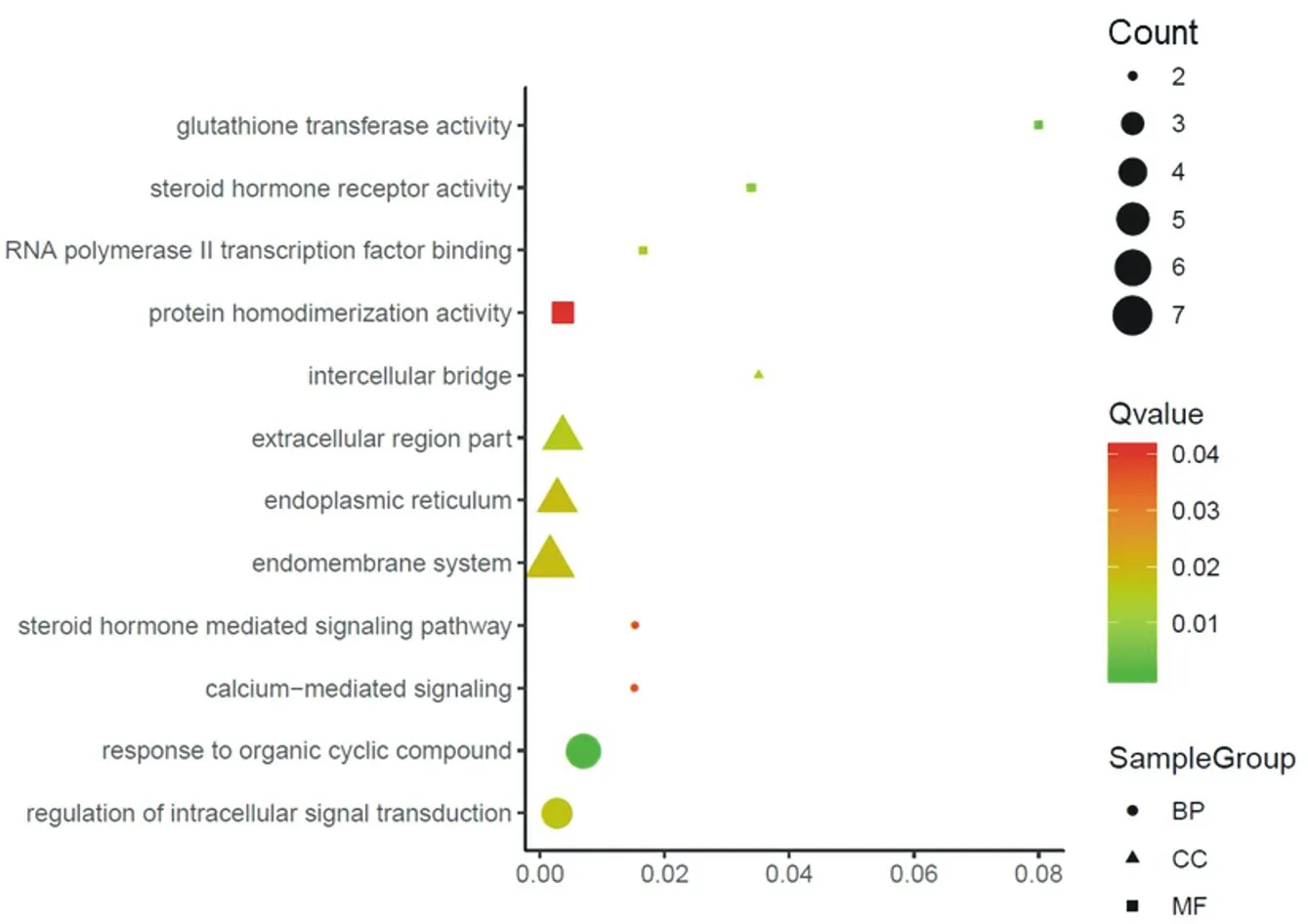
Figure 4 GO enrichment analysis

Figure 5 KEGG signal path analysis
4. Discussion
Osteoporosis, as a common disease of the elderly, has long plagued the daily lives of elderly patients, and Duhuo JiSheng Decoction has the effect of relieving clinical symptoms.In this study, based on bioinformatics analysis and network pharmacology, the differential genes of osteoporosis with kidney-yin deficiency and normal healthy people were screened out. Through the network pharmacology research, the "Duhuo-Fangfeng-Xixin-Sangjisheng" drug pair network was constructed, and the chemical composition of 4 important traditional Chinese medicines in Duhuo Parasitic Decoction was analyzed. It provides a reference for the research on the mechanism of action of ingredients, multiple targets and multiple pathways.
At present, for the treatment of osteoporosis, the commonly used western medicines are bisphosphonate preparations, which play a very important role in the treatment of osteoporosis [11], However, its side effects such as gastrointestinal tolerance, arthralgia and acute renal failure also limit its application. As the application of traditional Chinese medicine in osteoporosis is getting more and more attention, physicians have begun to find potential therapeutic molecules from traditional Chinese medicine [12].
Duhuo can dredging channel blockage, Xixin can dispelling wind, Fangfeng can dispelling pathogenic wind and removing dampness,Sangjisheng can nourish liver and kidney and Strengthen the muscles and bones. The combination of various medicines has the functions of dispel cold and remove damp, replenishing qi and blood and reinforce liver and kidney. Modern pharmacological studies have shown that Duhuo can effectively reduce the concentration of calcium, magnesium ions and ALP in serum, adjust cytokines to achieve the purpose of treating osteoporosis rats. Li gaofeng et al. showed that fangfeng may play an anti-osteoporosis role by regulating the levels of interleukin-6 and tumor necrosis factor [13]. Wang Yongfa et al. Studied the therapeutic effect of Dengzhan Xixin Oral Liquid on adjuvant arthritis rats, and the results suggest that Xixin has a better inhibitory effect on the pathology of adjuvant arthritis rats [14]. Wu Guihong's research shows [15] that mulberry parasite can increase bone mineral density (BMD) in ovariectomized rats, inhibit osteoporosis in ovariectomized rats, and regulate bone metabolism. Studies have shown that Duhuo has a therapeutic effect on ovariectomy-induced osteoporosis in rats, and promotes bone formation by activating the Wnt/ -catenin signaling pathway [16]. The above results are consistent with the GO enrichment analysis in this study, which mainly concentrates on calcium-mediated signaling, steroid hormone mediated signaling pathway,and KEGG analysis, which mainly concentrates on the P53 signaling pathway, TNF signaling pathway, il-17 signaling pathway and other apoptotic and inflammation-related signaling pathways. Among the 9 target genes that have been analyzed for possible effects of the active components of traditional Chinese medicine, the androgen receptor (AR) exists in osteoclasts. AR exists as a dimer and binds to a specific DNA sequence in the target cell nucleus: androgen response element (ARE), thereby regulating the expression of the target gene, which in turn produces biological effects [17]. Insulin-like growth factor binding protein-3 (IGFBP3) is a binding protein of insulin-like growth factor-1 (IGF-1). IGF-1 plays a regulatory role in the physiological process of bone remodeling. When combined with IGF-1, the release of IGF-1 in the serum is slowed down, thereby prolonging the half-life of IGF-1 and improving its effect [18]. In OP patients, its content decreases and leading to osteoporosis [19]. FOS is a proto-oncogene, and the protein it encodes is related to many factors in the regulation of cell growth [20]. Lin hua et al. confirmed that FOS is strongly expressed in bone cells of osteoporosis specimens, but almost no expression in normal control specimens [21]. Experimental studies have found that c-fos protein is of great significance to bone turnover [22, 23]. C-fos forms a dimer transcription factor AP-1 complex with the product of c-jun proto-oncogene, which promotes the transcription and expression of genes containing AP-1 binding sites related to bone growth and development, thereby affecting bone metabolism. It can be inferred that the effective active ingredients of Duhuo Jisheng decoction may play a therapeutic role in osteoporosis by regulating the corresponding target genes.
In summary, this study used bioinformatics analysis combined with network pharmacology to study the mechanism of active ingredients of Duhuo Jisheng decoction in the treatment of osteoporosis. Further extracting effective active ingredients from Duhuo Jisheng decoction provides a theoretical basis for the treatment of osteoporosis. However, as with most bioinformatics analysis studies, there are some limitations. If the study sample size is small, in addition, the differentially expressed genes and their related pathways in this study have not been confirmed by in vitro studies or other functional studies. Therefore, they need to be further verified by the use of experimental tests.
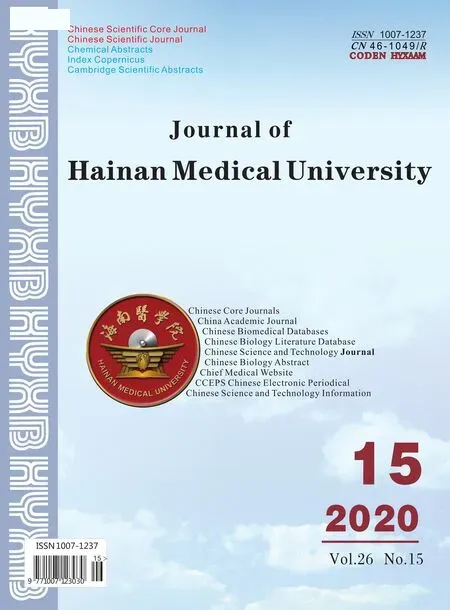 Journal of Hainan Medical College2020年15期
Journal of Hainan Medical College2020年15期
- Journal of Hainan Medical College的其它文章
- Clinical features and prognosis of patients with novel coronavirus pneumonia complicated with diabetes
- A nomogram of 5-year risk of type 2 diabetes in Chinese population
- Yiqi Huoxue Decoction in the treatment of Qi and yin deficiency and stasis type diabetic nephropathy in stage Ⅲ and its effect on VEGF and TGF-β1
- Relationship between nap and hypertension in adults: An updated meta-analysis
- A meta-analysis of the safety of clopidogrel and tegrarol in patients with non-ST elevation acute coronary syndrome after PCI in China
- Super-minimal incision kidney transplantation: Report of 6 cases
